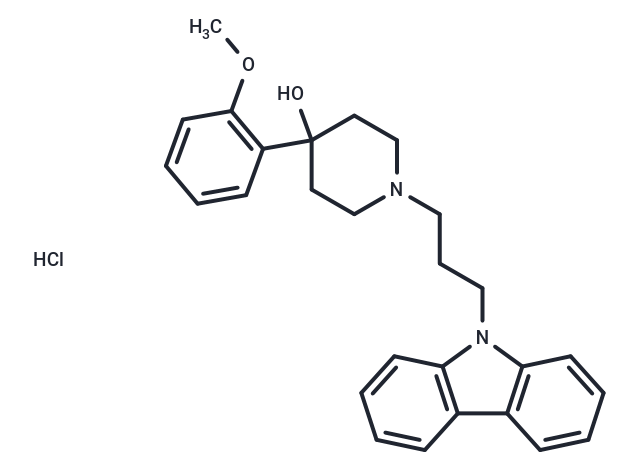Shopping Cart
- Remove All
 Your shopping cart is currently empty
Your shopping cart is currently empty

NNC 05-2090 hydrochloride is a betaine/GABA transporter (BGT-1) inhibitor with an IC50 value of 10.6 μM.NNC 05-2090 hydrochloride can be used for the study of epilepsy and neurological disorders.

| Pack Size | Price | Availability | Quantity |
|---|---|---|---|
| 1 mg | $44 | In Stock | |
| 5 mg | $105 | In Stock | |
| 10 mg | $172 | In Stock | |
| 25 mg | $389 | In Stock | |
| 50 mg | $697 | In Stock | |
| 100 mg | $1,080 | In Stock |
| Description | NNC 05-2090 hydrochloride is a betaine/GABA transporter (BGT-1) inhibitor with an IC50 value of 10.6 μM.NNC 05-2090 hydrochloride can be used for the study of epilepsy and neurological disorders. |
| In vitro | NNC05-2090 hydrochloride binds to prazosin and spiperone with IC50 values of 266 nM and 1632 nM, respectively.[1] NNC05-2090 hydrochloride (0.1-100 μM) inhibits [3H]GABA uptake in rat cortical synaptosomes with an IC50 value of 4.4 μM.[1] NNC05-2090 hydrochloride (0.1-100 μM) inhibits [3H]GABA uptake in inferior colliculus synaptosomes with an IC50 value of 2.5 μM.[1] NNC05-2090 hydrochloride inhibits serotonin, norepinephrine, dopamine transporter, and BGT-1 with IC50 values of 5.29, 7.91, 4.08, and 10.6 μM respectively.[1] NNC05-2090 hydrochloride inhibits GAT-1, GAT-2 and GAT-3 with IC50s of 29.62, 45.29 and 22.51 μM respectively.[1] |
| In vivo | NNC05-2090 hydrochloride (i.p.; PSL mice) dose-dependently protects mice from maximal electric shock (MES) ED50 of 73 μmol/kg and against tonic and clonic convulsions in DBA/2 mice with an ED50 of 19 μmol /kg and 26 μmol/kg.[1] NNC05-2090 hydrochloride (0.01, 0.1, 0.3 mg/kg; intraperitoneal or intrathecal injection; once) can dose-dependently reverse mechanical allodynia in PSL model mice by both intraperitoneal injection and intrathecal injection.[2] |
| Molecular Weight | 451 |
| Formula | C27H31ClN2O2 |
| Cas No. | 184845-18-9 |
| Smiles | Cl.OC1(C=2C=CC=CC2OC)CCN(CCCN3C=4C=CC=CC4C=5C=CC=CC53)CC1 |
| Relative Density. | no data available |
| Storage | Powder: -20°C for 3 years | In solvent: -80°C for 1 year | Shipping with blue ice. | |||||||||||||||||||||||||||||||||||
| Solubility Information | Ethanol: < 5.64 mg/mL, Sonication is recommended. DMSO: 50 mg/mL (110.86 mM), Sonication is recommended. | |||||||||||||||||||||||||||||||||||
Solution Preparation Table | ||||||||||||||||||||||||||||||||||||
DMSO
| ||||||||||||||||||||||||||||||||||||

Copyright © 2015-2025 TargetMol Chemicals Inc. All Rights Reserved.